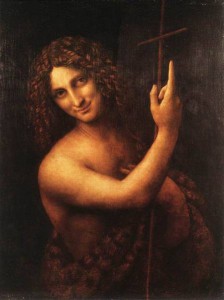Solstice celebrations have a long history… all the way back to prehistory, in fact. And you can count on things like this, handed down through the generations, to be fiercely protected. And so it was with people and the early Church as entire empires and city-states began converting to Christianity in those formative years. Old ways persisted a long time and still do, but the early Church opted to rededicate many of these celebrations. The Church placed the birth of Jesus Christ at the winter solstice and the birth of John the Baptist, who prepared his way, at the summer solstice, keeping those solstice celebrations in place but repurposing them to the celebrations we honor today.
Consider the imagery: John is born at Midsummer, just as light begins to decrease. “He must increase, but I must decrease,” we read in John 3:30. Conversely, Christ is born at Midwinter, just as light begins to increase. Again, in John 8:12: “I am the light of the world.” No one knows for sure the exact dates of birth of these two historical figures, but the Church knew what it was doing when it chose these dates, there’s no doubt. The message is a powerful one, especially when you go back to simpler times, before electricity: We were much more attuned to the patterns of increasing and decreasing sunlight in the past.
Most of the Midsummer traditions have to do with St. John’s Eve, which was last night. Still, one tradition is to cut divining rods on this day. Hidden treasures are also thought to reveal themselves on St. John’s Day (perhaps St. Anthony’s influence from earlier in the month?). Explore lonely places, it is said, and there these treasures shall be, awaiting any lucky finder. The magic passes with the day.
St. John the Baptist is unusual in that he is the only saint for which we celebrate his birth (today) in addition to his death (August 29). So you’ll see his name come around again in late summer. St. John is sacred to Puerto Rico, Québec and Newfoundland. He is a patron saint of tailors, innkeepers, and printers like me. It is customary to eat strawberries on his feast day, and in Estonia and Finland, a special St. John’s Day cheese is made, flavored with caraway seeds. Luckily no one has made a tradition of eating the foods that St. John himself is known to have eaten: “And his meat was locusts and wild honey” (Matthew 3:4). Try serving that at your next Midsummer dinner and watch your guests clear out in a hurry.
As with Christmas at the opposite solstice, it is the eve of the feast that is charged with more magic and mystery. And especially so with St. John’s Eve. The fires of people across the planet were blazing last night, lighting the midsummer night, calling down the power of the sun, marking our celebrations across time and geography.
Image: St. John the Baptist by Leonardo DaVinci [Public domain], via Wikimedia Commons.
